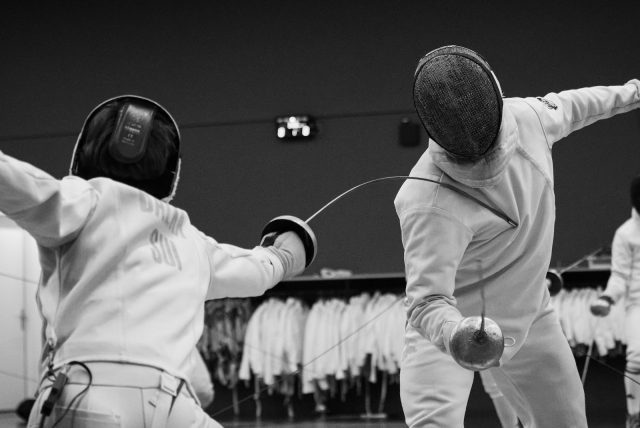Fencing is a centuries-old sport with deep roots in history and culture. It has resurfaced in recent years as a popular form of physical activity and exercise. Thanks to its full-body workout and mental stimulation. Swordplay offers an exciting way for anyone to get fit, regardless of age or experience. For those looking to start fencing training, a few tips can help you on your journey.
What is Fencing?
Fencing is a sport that traces its roots back to the days of sword fighting. Today, it is a modern Olympic sport that involves two competitors facing off against each other with specialized swords called foils, epees, or sabers. Fencing aims to score points by touching your opponent with the tip of your sword while avoiding being touched yourself.
Fencing is a sport that requires a combination of physical and mental abilities. On the physical side, fencers need good hand-eye coordination, flexibility, and quick reflexes to succeed. They also need to have excellent footwork and endurance since fencing requires constant movement and quick changes in direction.
On the mental side, fencing requires strategy, focus, and quick decision-making. Fencers need to be able to read their opponent’s movements and anticipate their next move, all while staying calm and composed under pressure.
Fencing is a sport that is accessible to people of all ages and abilities. It is a great workout that benefits the cardiovascular and muscular and improves balance, coordination, and reaction time. Fencing can also be a social activity, as it is often practiced in clubs where fencers can meet and train with like-minded individuals.
In addition to being a fun and exciting sport, fencing is also a valuable self-defense skill. Learning to fence can improve your reaction time, coordination, and confidence in handling potentially dangerous situations.
Overall, fencing is a unique and challenging sport that offers a combination of physical and mental benefits.
Benefits of Fencing
Fencing is a sport that offers a variety of physical, mental, and social benefits. Here are some of the key advantages of taking up fencing:
- Improved Physical Fitness: Fencing is a full-body workout that improves strength, agility, and endurance. The sport requires constant movement and quick reflexes, which helps to build cardiovascular fitness and muscle strength. Fencing also helps to improve balance, coordination, and flexibility, as fencers need to move quickly and change direction smoothly.
- Mental Agility: Fencing requires quick decision-making, strategic thinking, and mental agility. Fencers need to be able to read their opponents’ movements and anticipate their next move, all while staying calm and composed under pressure. The sport helps to develop mental focus and discipline, which can be helpful in all areas of life.
- Self-Defense Skills: Learning to fence can be a valuable self-defense skill. Fencers learn how to anticipate and react to potential threats, as well as how to defend themselves in close quarters. The sport can help build confidence and assertiveness in potentially dangerous situations.
- Socialization: Fencing is often practiced in clubs, which provides a supportive and social environment for fencers. Club members can meet and train with like-minded individuals, and many clubs organize social events and competitions. Fencing can help to build social skills and friendships, which can be particularly beneficial for children and adolescents.
- Competitive Opportunities: Fencing is a competitive sport, with opportunities to compete at local, national, and even international levels. Competing in fencing can provide a sense of accomplishment and a way to track progress in skill development.
Fencing is a unique and rewarding sport that offers a range of physical, mental, and social benefits. Whether you are looking for a fun way to get fit, a valuable self-defense skill, or a competitive sport to master, fencing is worth considering.
Equipment Needed

Fencing is a sport that requires specialized equipment to ensure the safety of the fencers.
- Fencing Mask: A fencing mask is an essential equipment that protects the fencer’s face and head. The mask is made of a metal mesh covering the face’s front and the head’s top and back. It also has a bib that covers the neck and throat.
- Fencing Jacket: A fencing jacket is a thick, padded garment that protects the fencer’s torso. The jacket is made of heavy fabric, such as cotton or nylon, and has reinforced padding on the chest and back.
- Fencing Glove: A fencing glove is a padded glove that protects the fencer’s sword hand. The glove is typically made of leather or synthetic material and has a reinforced palm and padding on the back of the hand.
- Fencing Sword: Fencing swords are called foils, epees, or sabers, depending on the type of fencing practiced. The swords are made of lightweight materials, such as steel or aluminum, and are designed to be flexible and responsive.
- Fencing Lame: A fencing lame is a metallic jacket worn over the fencing jacket to help determine the scoring of hits. The lame is electrically conductive and registers hits made with the fencing sword.
- Fencing Shoes: Fencing shoes are specialized footwear that provides good traction and support for the fencer’s feet. The shoes are typically lightweight and have a flat sole for good balance.
In addition to these essential items, fencers may also use optional equipment such as fencing pants, chest protectors, and extra padding for additional protection. It’s important to choose high-quality fencing equipment that fits properly and is in good condition to ensure the safety of the fencers. You can purchase fencing equipment at specialty stores or online, and many fencing clubs also rent equipment for beginners who are just starting out.
Finding a Teacher
Finding a qualified fencing teacher is essential for learning the sport’s proper techniques and safety protocols. Here are some tips on how to find a good fencing teacher:
- Check with Local Fencing Clubs: Local fencing clubs are often the best place to start when looking for a fencing teacher. These clubs typically have certified coaches on staff and offer lessons for beginners and experienced fencers. You can search for clubs in your area online or through the United States Fencing Association (USFA).
- Attend Fencing Tournaments: Fencing tournaments are a great way to observe fencing coaches in action and understand their teaching style. Many coaches attend tournaments to support their students and may be available to discuss lessons and training options.
- Ask for Referrals: Ask friends or acquaintances who have experience with fencing if they can recommend a good teacher or club. You can also ask your local sports authority or community center if they have any recommendations.
- Look for Qualifications: Look for a fencing teacher who is certified by the USFA or another recognized governing body. Certified coach has undergone training and testing to ensure that they have the necessary skills and knowledge to teach fencing.
- Evaluate Teaching Style: Different fencing teachers may have different teaching styles, so finding a coach whose style matches your learning preferences is essential. Some teachers focus more on technique, while others emphasize strategy or fitness. It’s important to find a teacher who can help you reach your specific goals in fencing.
- Try Out a Lesson: Once you have identified a potential teacher or club, it’s a good idea to try out a lesson or two to see if it’s a good fit. Many fencing clubs offer introductory lessons for beginners, which can be a great way to get started and see if you enjoy the sport and the teaching style.
Overall, finding a good fencing teacher is important in learning the sport and developing the necessary skills and techniques. With a bit of research and some trial and error, you can find a teacher who can help you achieve your fencing goals.
Training Basics
Fencing requires a combination of physical and mental skills, and developing a strong foundation is essential for success in the sport. Here are some training basics for beginners:
- Footwork: Footwork is a fundamental aspect of fencing and involves a series of steps and movements used to advance, retreat, and change direction. Proper footwork is essential for maintaining balance and control during a fencing match.
- Blade Work: Blade work involves learning the different types of attacks and defenses used in fencing. This includes the basic attacks such as the lunge, thrust, and parry, as well as more advanced techniques such as the feint and disengage.
- Conditioning: Fencing requires a high level of physical fitness, including strength, endurance, and agility. Regular conditioning exercises like running, jumping, and resistance training can help improve overall fitness and performance.
- Strategy and Tactics: Fencing is a sport that requires a combination of physical and mental skills. Understanding fencing strategy and tactics are essential for success in the sport. This includes learning to read your opponent’s moves, anticipate their attacks, and develop a counter-strategy.
- Mental Focus: Fencing requires intense mental focus and concentration. Developing techniques to improve focus, such as visualization and meditation, can help fencers stay calm and centered during matches.
- Practice: Consistent practice is essential for improving fencing skills and developing muscle memory. Fencers should aim to practice regularly, ideally with a qualified coach or experienced training partner.
Overall, developing a strong foundation in footwork, blade work, conditioning, strategy and tactics, mental focus, and consistent practice is essential for success in fencing. By mastering these basics, fencers can improve their overall performance and reach their fencing goals.
Conclusion: Get Started with Fencing
Fencing is a unique and exciting sport that combines physical and mental skills. Making it a great option for anyone looking for a fun and challenging athletic pursuit. Whether you’re a beginner or an experienced athlete. Fencing requires a solid foundation in training basics, including footwork, blade work, conditioning, strategy and tactics, mental focus, and consistent practice.
Finding a qualified fencing teacher and investing in the right equipment are essential steps to beginning your fencing journey. Once you have the necessary tools and skills, the possibilities for growth and achievement in fencing are endless.
Not only does fencing offer physical benefits such as improved fitness and strength, but it also provides opportunities for personal growth, such as increased confidence and mental fortitude.






























